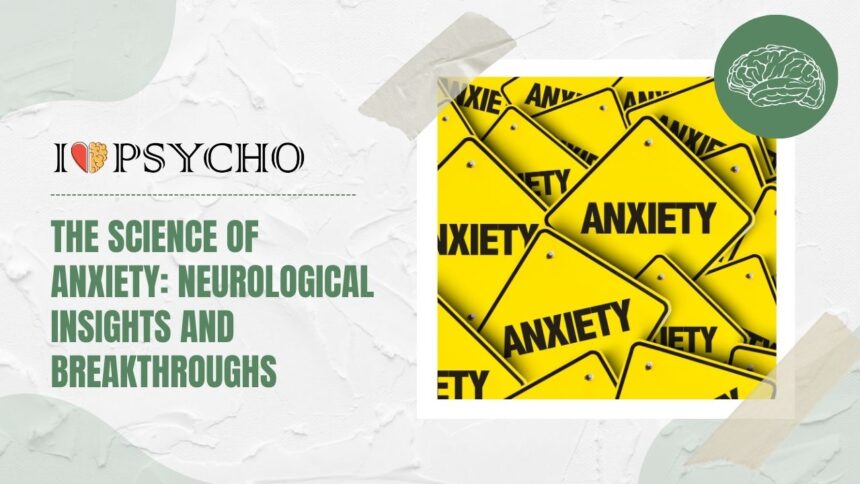Anxiety – a familiar yet complex emotion that can grip us in its relentless hold, affecting our daily lives and mental well-being. But have you ever wondered about the science behind anxiety? Delve into this intriguing world with us as we uncover the neurological insights and breakthroughs that shed light on this common yet often misunderstood condition. Join us on a journey through the inner workings of the brain, unraveling the mysteries of anxiety along the way.
Understanding Anxiety: Definition and Symptoms
Anxiety, a natural response to stress, can manifest in various forms and intensities. It goes beyond mere worry or fear, often causing excessive unease and apprehension. Symptoms may range from physical manifestations like rapid heartbeat and sweating to psychological indicators such as racing thoughts and irrational fears.
Individuals experiencing anxiety may find themselves constantly on edge, anticipating potential threats even in non-threatening situations. This heightened sense of alertness can disrupt daily functioning and lead to feelings of overwhelming distress. Understanding the nuances of anxiety involves recognizing these diverse symptoms that can impact both mind and body.
By acknowledging the multifaceted nature of anxiety, we begin to appreciate its complexities and the need for tailored approaches towards managing it effectively. Through awareness and insight into these defining characteristics, we pave the way for greater understanding and support for those navigating the challenges posed by anxiety.
The Role of Neurotransmitters in Anxiety
When it comes to understanding anxiety, delving into the realm of neurotransmitters is crucial. These chemical messengers play a significant role in how our brain functions and can directly impact our mood and emotions.
One key player in anxiety is serotonin, often referred to as the “feel-good” neurotransmitter. Low levels of serotonin have been linked to feelings of unease and worry. On the other hand, gamma-aminobutyric acid (GABA) acts as a calming agent in the brain, helping to reduce excessive neuronal activity that can lead to anxiety.
Dopamine also plays a part in anxiety disorders, influencing motivation and reward-seeking behaviors. Imbalances in dopamine levels can contribute to heightened stress responses and anxious feelings.
Understanding these intricate interactions between neurotransmitters is essential for developing targeted treatments that address the root causes of anxiety at a neurological level.
Brain Regions Involved in Anxiety Disorders
Anxiety disorders are complex conditions that involve various brain regions working together in intricate ways. The amygdala, often referred to as the brain’s “fear center,” plays a crucial role in processing emotions and triggering the body’s stress response. When overactive, it can contribute to heightened anxiety levels.
The prefrontal cortex, responsible for decision-making and regulating emotions, also comes into play with anxiety disorders. Dysfunction in this region may lead to difficulties in controlling anxious thoughts and behaviors.
Additionally, the hippocampus, involved in memory formation and emotional regulation, can be affected by chronic stress associated with anxiety disorders. Changes in this area may impact how individuals process and respond to stressful situations.
Understanding how these brain regions interconnect and influence one another provides valuable insight into the underlying mechanisms of anxiety disorders. Researchers continue to explore these relationships to develop more targeted treatments for individuals struggling with anxiety.
Genetics and Environmental Factors in Anxiety
Genetics plays a significant role in the development of anxiety disorders. Research suggests that certain genetic variations can increase susceptibility to anxiety, affecting how our brains respond to stress and fear. These genetic factors can influence the production and regulation of neurotransmitters, impacting mood and anxiety levels.
Environmental factors also contribute to the manifestation of anxiety. Childhood experiences, trauma, chronic stress, and even societal pressures can all play a part in triggering or exacerbating anxiety symptoms. The interplay between genetics and environment is complex, with both factors interacting to shape an individual’s risk for developing an anxiety disorder.
Understanding these genetic and environmental influences is crucial for personalized treatment approaches. By identifying specific risk factors unique to each individual, healthcare providers can better tailor interventions that address both the biological predispositions and external triggers contributing to their anxiety symptoms.
Current Treatments for Anxiety and Their Limitations
For those grappling with anxiety, the current treatment landscape offers a variety of options. From therapy to medication, individuals have choices in managing their symptoms. Cognitive-behavioral therapy (CBT) helps reframe negative thought patterns, while medications like SSRIs can regulate neurotransmitters linked to anxiety.
However, these treatments come with limitations. Therapy may be time-consuming and require consistent effort from the individual. Medications can have side effects and may not work for everyone. Moreover, there’s a need for more personalized approaches as what works for one person may not work for another.
Alternative therapies such as mindfulness meditation and yoga are gaining recognition for their potential benefits in reducing anxiety. Lifestyle changes like exercise and nutrition also play a role in overall mental well-being.
As research continues to evolve, it’s crucial to explore new avenues in treating anxiety effectively.
Emerging Research on Alternative Therapies for Anxiety
As our understanding of anxiety deepens, researchers are exploring alternative therapies that go beyond traditional treatments. One promising area of study is the use of mindfulness techniques to calm the mind and reduce anxiety levels. Mindfulness involves focusing on the present moment without judgment, which can help individuals manage their anxious thoughts more effectively.
Another emerging approach is the use of herbal supplements like passionflower and valerian root, known for their calming properties. These natural remedies offer a gentler way to alleviate anxiety symptoms without the side effects often associated with prescription medications.
Recent studies have also investigated the benefits of acupuncture in reducing anxiety by balancing energy flow within the body. This ancient practice shows promise in providing relief for those struggling with persistent worry and fear.
As research continues to explore innovative ways to address anxiety, individuals may have access to a wider range of treatment options tailored to their specific needs.
The Future of Treating Anxiety: Breakthroughs and Possibilities
As we delve into the future of treating anxiety, exciting breakthroughs and possibilities emerge on the horizon. Researchers are exploring innovative therapies like virtual reality exposure therapy to help individuals confront their fears in a controlled environment.
Advancements in neuroimaging techniques are allowing scientists to gain deeper insights into the neural circuits involved in anxiety disorders, paving the way for more targeted interventions. Additionally, personalized medicine approaches based on genetic markers may revolutionize how we tailor treatments to individual needs.
Furthermore, novel pharmaceuticals targeting specific neurotransmitter systems show promise in modulating anxiety symptoms with fewer side effects. Integrative approaches combining traditional therapies with mindfulness practices and lifestyle modifications offer holistic avenues for managing anxiety.
With ongoing research and technological advancements, the future holds immense potential for transforming how we understand and address anxiety disorders effectively.
Coping Mechanisms for Dealing with Anxiety
Living with anxiety can be challenging, but there are coping mechanisms that can help manage its effects. One effective strategy is practicing mindfulness and deep breathing exercises to stay grounded in the present moment. Engaging in regular physical activity like yoga or jogging can also release endorphins to improve mood. Another helpful technique is journaling thoughts and feelings to gain clarity and perspective on triggers.
Seeking support from loved ones or a therapist provides a safe space for expressing emotions and receiving guidance. Creating a routine that includes self-care activities such as meditation, hobbies, or spending time outdoors can promote relaxation and reduce stress levels. Remember, it’s okay to prioritize your mental well-being by exploring various coping strategies until you find what works best for you.
Conclusion
As we continue to unravel the complexities of anxiety through scientific research and breakthroughs, it becomes evident that a multidimensional approach is necessary for understanding and treating this common mental health condition. From neurotransmitters to genetics, from brain regions to coping mechanisms, there is a vast landscape of factors at play when it comes to anxiety.
While current treatments have their limitations, the emergence of alternative therapies offers hope for those seeking new ways to manage their symptoms. With ongoing research paving the way for novel interventions and advancements in neurology shedding light on the intricate workings of the anxious mind, the future holds promise for more effective approaches towards combating anxiety.
In our quest to navigate the science behind anxiety, let us remember that each individual’s experience with this pervasive condition is unique. By fostering a deeper understanding of its neurological underpinnings and exploring diverse treatment modalities, we can strive towards a future where individuals grappling with anxiety find solace in tailored solutions that address both their physiological and psychological needs.
May we continue to support one another on this journey towards mental well-being and empower those affected by anxiety with knowledge, compassion, and resilience.









